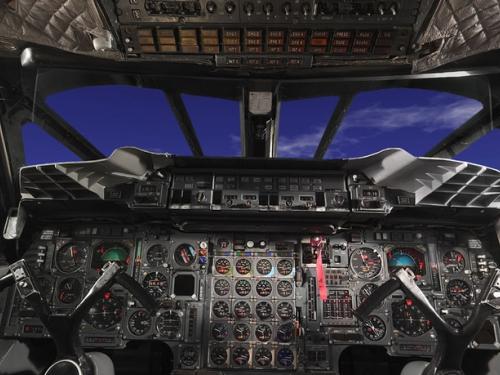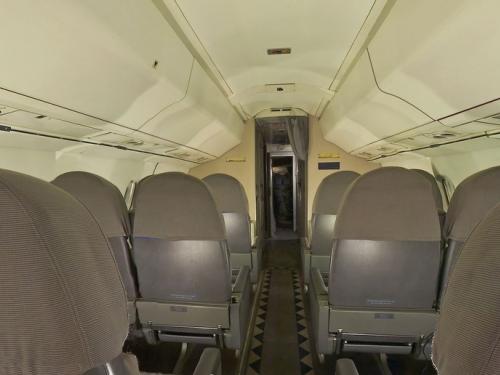The first supersonic airliner to enter service, the Concorde flew thousands of passengers across the Atlantic at twice the speed of sound for over 25 years. Designed and built by Aérospatiale of France and the British Aircraft Corporation, the graceful Concorde was a stunning technological achievement that could not overcome serious economic problems.
In 1976 Air France and British Airways jointly inaugurated Concorde service to destinations around the globe. Carrying up to 100 passengers in great comfort, the Concorde catered to first class passengers for whom speed was critical. It could cross the Atlantic in fewer than four hours - half the time of a conventional jet airliner. However its high operating costs resulted in very high fares that limited the number of passengers who could afford to fly it. These problems and a shrinking market eventually forced the reduction of service until all Concordes were retired in 2003.
In 1989, Air France signed a letter of agreement to donate a Concorde to the National Air and Space Museum upon the aircraft's retirement. On June 12, 2003, Air France honored that agreement, donating Concorde F-BVFA to the Museum upon the completion of its last flight. This aircraft was the first Air France Concorde to open service to Rio de Janeiro, Washington, D.C., and New York and had flown 17,824 hours.
It began with a dream - a dream of a new age in air travel where the boundaries of time and distance were to have been shattered forever. The dream of supersonic passenger air travel was first conceived in the 1950s was developed in the 1960s and came to fruition in the mid 1970s. For 27 years, the graceful Anglo-French Concorde carried world travelers across the Atlantic Ocean in great comfort at twice the speed of sound. While the dream was real, it was so only for the world's privileged elites. It was not a machine for the average citizen. High development costs and high operating costs prevented the Concorde from achieving the dream of practical supersonic flight for the public. But for a while, the Concorde looked promising - it looked like the future.
In the 1950s air travel was revolutionized with the advent of jet propulsion. First the de Havilland Comet and later, the Boeing 707, greatly increased the speed of travel from 350 to over 600 mile per hour. Airlines and customers flocked to the new jet airliners as travel times were cut dramatically and the seat-mile costs to the airlines dropped. The conclusion drawn by engineers, managers, and politicians seemed clear: the faster the better.
In Europe, enterprising designers in Great Britain and France were independently outlining their plans for a supersonic transport (SST). In November 1962, in a move reminiscent of the Entente Cordiale of 1904, the two nations agreed to pool their resources and share the risks in building this new aircraft. They also hoped to highlight Europe's growing economic unity as well as its aerospace expertise in a dramatic and risky bid to supplant the United States as the leader in commercial aviation. The aircraft's name reflected the shared hopes of each nation for success through cooperation - Concorde.
Quickly the designers at the British Aircraft Corporation and Sud Aviation, later reorganized as Aerospatiale, settled on a slim, graceful form featuring an ogival delta wing that possessed excellent low speed and high speed handling characteristics. Power was to be provided by four massive Olympus turbojet engines built by Rolls-Royce and SNECMA. Realizing that this first generation SST would cater to the wealthier passenger, Concorde's designers created an aircraft that carried only 100 seats in tight four-across rows. They assumed that first class passengers would flock to the Concorde to save valuable time while economy class passengers would remain in larger, but slower subsonic airliners.
Despite mounting costs that constantly threatened the program, construction continued with exactly 50 percent of each aircraft built in each country. The first Concorde was ready for flight in 1969. With famed French test pilot Andre Turcot at the controls, Concorde 001, which was assembled at Toulouse, took to the air on March 2, 1969. Although the Soviets had flown their version of the SST first, the Tupolev Tu-144 had been rushed into production and suffered from technological problems that could never be solved. Following the successful first flight a total of four prototype and preproduction Concordes were built and thoroughly tested and by 1976, the first of 16 production Concordes were ready for service. Twenty were built in all.
But all was not rosy. During this time America sought to produce its own bigger and faster SST. After a contentious political debate, the federal government refused to back the project in 1971 citing environmental problems, particularly noise, the sonic boom, and engine emissions that were thought to harm the upper atmosphere. Anti SST political activity in the United States delayed the granting of landing rights, particularly into New York City, causing further delays.
More ominously for Concorde, no airlines placed orders for this advanced SST. Despite initial enthusiasm, the airlines dropped their purchase options once they calculated the operating costs of the Concorde. Consequently only Air France and British Airways - the national airlines of their respective countries - flew the 16 production aircraft and only after purchasing them from their governments at virtually no cost.
Nevertheless, in January 1976, Concorde service began and, by November, these graceful SSTs were flying to the United States. A technological masterpiece, each Concorde smoothly transitioned to supersonic flight with no discernable disturbance to the passenger. In service, the Concorde would cruise at twice the speed of sound between 55,000 and 60,000 feet - so high that passengers could actually see the curvature of the Earth. The Concorde was so fast that, despite the outside temperature of less than -56 degrees Celsius, the aircraft's aluminum skin would heat up to over 120 degrees Celsius while the Concorde actually expanded 8 inches in length with the interior of the window gradually growing quite warm to the touch. And all the while each passenger was carefully attended to while enjoying a magnificent meal and superb service. Transatlantic flight time was cut in half with the average flight taking less than four hours.
For the next 27 years supersonic travel was the norm for the world's business and entertainment elite. But eventually the harsh reality of the economic marketplace forced Air France and British Airways to cut back their already limited service. Routes from London and Paris to Washington, Rio de Janeiro, Caracas, Miami, Singapore, and other locations were cut leaving only the transatlantic service to New York. And even on most of these flights, the Concorde flew half full with many of the passenger flying as guests of the airlines or as upgrades. With the average round trip ticket costing more than $12,000, few could afford to fly this magnificent aircraft. Operating costs escalated as parts became more difficult to acquire and, with an average of one ton of fuel consumed per seat, the already small market for the Concorde gradually grew smaller.
Despite the excellence of the Concorde's design, its operators realized that its days were numbered because of its high costs. In 1989, in commemoration of the 200th anniversary of the French Revolution and the 200th anniversary of the ratification of the Constitution of the United States, the French government sent a copy of the Declaration of the Rights of Man to the U.S. Appropriately, this famous document was delivered on the Concorde and with it a promise from Air France to give one of these aircraft to the people of the United States through its eventual inclusion into the collection of the Smithsonian Institution's National Air and Space Museum.
Fourteen years later that promised was fulfilled. In April of 2003 Air France president Jean Cyril Spinetta informed the Museum in April that Concorde service would end on May 31st following the decision by the aircraft's manufacturer to stop supporting the fleet. As planned, on June 12 Air France delivered its most treasured Concorde, F-BVFA, to Washington Dulles International Airport on its last supersonic flight for the airline. This aircraft was the first production Concorde delivered to Air France, the first Concorde to open service between Paris and New York, Washington, and Rio de Janeiro and had amassed 17,824 hours in the air. Onboard were 60 passengers including Gilles de Robien, the French Minister for Capital Works, Transport, Housing, Tourism, and Marine Affairs, Mr. Spinetta, and several past Air France presidents as well as former Concorde pilots and crew members. In a dignified yet bittersweet ceremony Mr. Spinetta signed over Concorde "Fox Alpha" to the Museum for permanent safekeeping.
The Concorde is now prominently displayed at the Museum's Steven F. Udvar-Hazy Center.
This object is on display in Business Aviation at the Steven F. Udvar-Hazy Center in Chantilly, VA.
Societe Nationale Industrielle Aerospatiale
Length: 61.66 m (202 ft 3 in)
Height: 11.3 m (37 ft 1 in)
Weight, empty: 79,265 kg (174,750 lb)
Weight, gross: 181,435 kg (400,000 lb)
Top speed: 2,179 km/h (1350 mph)
Engine: Four Rolls-Royce/SNECMA Olympus 593 Mk 602, 17,259 kg (38,050 lb) thrust each
Manufacturer: Société Nationale Industrielle Aérospatiale, Paris, France, and British Aircraft Corporation, London, United Kingdom
For more information, visit the Smithsonians Terms of Use.

